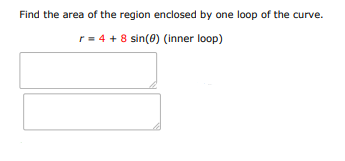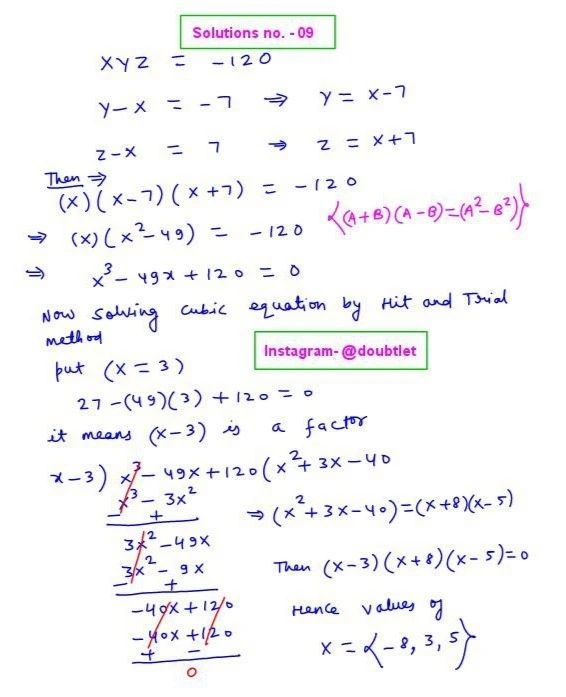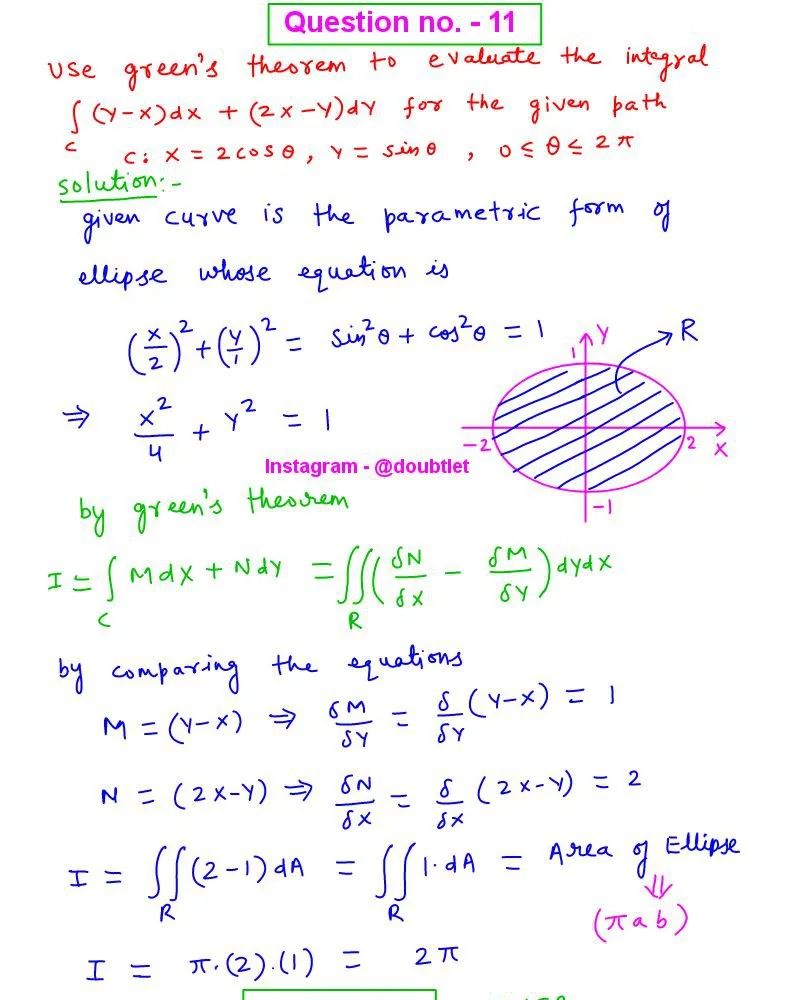Neetesh Kumar | January 1, 2025
Calculus Homework Help
This is the solution to Math 1c Assignment: 10.4 Question Number 6 Contact me if you need help with Homework, Assignments, Tutoring Sessions, or Exams for STEM subjects. Testimonials or Vouches from here of the previous works I have done.
Get Homework Help
Step-by-step solution:
To calculate the area enclosed by one loop of the given polar curve, we use the formula for the area in polar coordinates:
A = 1 2 ∫ θ 1 θ 2 r 2 d θ A = \frac{1}{2} \int_{\theta_1}^{\theta_2} r^2 \, d\theta A = 2 1 ∫ θ 1 θ 2 r 2 d θ
Here, r = 4 + 8 sin ( θ ) r = 4 + 8\sin(\theta) r = 4 + 8 sin ( θ )
Since we are focusing on the inner loop, we need to determine the limits of integration θ 1 \theta_1 θ 1 θ 2 \theta_2 θ 2
Step 1: Identify the limits of integration for the inner loop:
For an inner loop in a polar curve, the loop corresponds to the portion where r = 0 r = 0 r = 0
Setting r = 0 r = 0 r = 0
4 + 8 sin ( θ ) = 0 4 + 8\sin(\theta) = 0 4 + 8 sin ( θ ) = 0
sin ( θ ) = − 1 2 \sin(\theta) = -\frac{1}{2} sin ( θ ) = − 2 1
The solutions for sin ( θ ) = − 1 2 \sin(\theta) = -\frac{1}{2} sin ( θ ) = − 2 1 [ 0 , 2 π ] [0, 2\pi] [ 0 , 2 π ]
θ = 7 π 6 \theta = \frac{7\pi}{6} θ = 6 7 π θ = 11 π 6 \theta = \frac{11\pi}{6} θ = 6 11 π
Thus, the inner loop occurs as θ \theta θ 7 π 6 \frac{7\pi}{6} 6 7 π 11 π 6 \frac{11\pi}{6} 6 11 π
Step 2: Set up the integral for the area:
The area of the inner loop is:
A = 1 2 ∫ 7 π 6 11 π 6 ( 4 + 8 sin ( θ ) ) 2 d θ A = \frac{1}{2} \int_{\frac{7\pi}{6}}^{\frac{11\pi}{6}} \left(4 + 8\sin(\theta)\right)^2 \, d\theta A = 2 1 ∫ 6 7 π 6 11 π ( 4 + 8 sin ( θ ) ) 2 d θ
Step 3: Expand r 2 r^2 r 2
Expand ( 4 + 8 sin ( θ ) ) 2 \left(4 + 8\sin(\theta)\right)^2 ( 4 + 8 sin ( θ ) ) 2
( 4 + 8 sin ( θ ) ) 2 = 16 + 64 sin ( θ ) + 64 sin 2 ( θ ) \left(4 + 8\sin(\theta)\right)^2 = 16 + 64\sin(\theta) + 64\sin^2(\theta) ( 4 + 8 sin ( θ ) ) 2 = 16 + 64 sin ( θ ) + 64 sin 2 ( θ )
So, the integral becomes:
A = 1 2 ∫ 7 π 6 11 π 6 ( 16 + 64 sin ( θ ) + 64 sin 2 ( θ ) ) d θ A = \frac{1}{2} \int_{\frac{7\pi}{6}}^{\frac{11\pi}{6}} \left(16 + 64\sin(\theta) + 64\sin^2(\theta)\right) \, d\theta A = 2 1 ∫ 6 7 π 6 11 π ( 16 + 64 sin ( θ ) + 64 sin 2 ( θ ) ) d θ
Step 4: Simplify and compute the integral:
Split the integral into three parts:
A = 1 2 [ ∫ 7 π 6 11 π 6 16 d θ + ∫ 7 π 6 11 π 6 64 sin ( θ ) d θ + ∫ 7 π 6 11 π 6 64 sin 2 ( θ ) d θ ] A = \frac{1}{2} \left[ \int_{\frac{7\pi}{6}}^{\frac{11\pi}{6}} 16 \, d\theta + \int_{\frac{7\pi}{6}}^{\frac{11\pi}{6}} 64\sin(\theta) \, d\theta + \int_{\frac{7\pi}{6}}^{\frac{11\pi}{6}} 64\sin^2(\theta) \, d\theta \right] A = 2 1 [ ∫ 6 7 π 6 11 π 16 d θ + ∫ 6 7 π 6 11 π 64 sin ( θ ) d θ + ∫ 6 7 π 6 11 π 64 sin 2 ( θ ) d θ ]
First Term:
∫ 7 π 6 11 π 6 16 d θ = 16 ⋅ ( 11 π 6 − 7 π 6 ) = 16 ⋅ 4 π 6 = 64 π 6 = 32 π 3 \int_{\frac{7\pi}{6}}^{\frac{11\pi}{6}} 16 \, d\theta = 16 \cdot \left(\frac{11\pi}{6} - \frac{7\pi}{6}\right) = 16 \cdot \frac{4\pi}{6} = \frac{64\pi}{6} = \frac{32\pi}{3} ∫ 6 7 π 6 11 π 16 d θ = 16 ⋅ ( 6 11 π − 6 7 π ) = 16 ⋅ 6 4 π = 6 64 π = 3 32 π
Second Term:
∫ 7 π 6 11 π 6 64 sin ( θ ) d θ \int_{\frac{7\pi}{6}}^{\frac{11\pi}{6}} 64\sin(\theta) \, d\theta ∫ 6 7 π 6 11 π 64 sin ( θ ) d θ
The integral of 64 sin ( θ ) 64\sin(\theta) 64 sin ( θ ) [ 7 π 6 , 11 π 6 ] [\frac{7\pi}{6}, \frac{11\pi}{6}] [ 6 7 π , 6 11 π ]
∫ 7 π 6 11 π 6 64 sin ( θ ) d θ = 64 ⋅ [ − cos ( θ ) ] 7 π 6 11 π 6 \int_{\frac{7\pi}{6}}^{\frac{11\pi}{6}} 64\sin(\theta) \, d\theta = 64 \cdot \left[-\cos(\theta)\right]_{\frac{7\pi}{6}}^{\frac{11\pi}{6}} ∫ 6 7 π 6 11 π 64 sin ( θ ) d θ = 64 ⋅ [ − cos ( θ ) ] 6 7 π 6 11 π
Evaluate − cos ( θ ) -\cos(\theta) − cos ( θ )
− cos ( 11 π 6 ) = − ( 3 2 ) , − cos ( 7 π 6 ) = − ( − 3 2 ) -\cos\left(\frac{11\pi}{6}\right) = -\left(\frac{\sqrt{3}}{2}\right), \quad -\cos\left(\frac{7\pi}{6}\right) = -\left(-\frac{\sqrt{3}}{2}\right) − cos ( 6 11 π ) = − ( 2 3 ) , − cos ( 6 7 π ) = − ( − 2 3 )
So:
∫ 7 π 6 11 π 6 64 sin ( θ ) d θ = 64 ⋅ ( − 3 2 + 3 2 ) = − 64 3 \int_{\frac{7\pi}{6}}^{\frac{11\pi}{6}} 64\sin(\theta) \, d\theta = 64 \cdot \left(-\frac{\sqrt{3}}{2} + \frac{\sqrt{3}}{2}\right) = -64\sqrt{3} ∫ 6 7 π 6 11 π 64 sin ( θ ) d θ = 64 ⋅ ( − 2 3 + 2 3 ) = − 64 3
Third Term:
Use the identity sin 2 ( θ ) = 1 2 ( 1 − cos ( 2 θ ) ) \sin^2(\theta) = \frac{1}{2}(1 - \cos(2\theta)) sin 2 ( θ ) = 2 1 ( 1 − cos ( 2 θ ))
∫ 7 π 6 11 π 6 64 sin 2 ( θ ) d θ = 64 ⋅ 1 2 ∫ 7 π 6 11 π 6 ( 1 − cos ( 2 θ ) ) d θ \int_{\frac{7\pi}{6}}^{\frac{11\pi}{6}} 64\sin^2(\theta) \, d\theta = 64 \cdot \frac{1}{2} \int_{\frac{7\pi}{6}}^{\frac{11\pi}{6}} (1 - \cos(2\theta)) \, d\theta ∫ 6 7 π 6 11 π 64 sin 2 ( θ ) d θ = 64 ⋅ 2 1 ∫ 6 7 π 6 11 π ( 1 − cos ( 2 θ )) d θ
= 32 [ ∫ 7 π 6 11 π 6 1 d θ − ∫ 7 π 6 11 π 6 cos ( 2 θ ) d θ ] = 32 \left[ \int_{\frac{7\pi}{6}}^{\frac{11\pi}{6}} 1 \, d\theta - \int_{\frac{7\pi}{6}}^{\frac{11\pi}{6}} \cos(2\theta) \, d\theta \right] = 32 [ ∫ 6 7 π 6 11 π 1 d θ − ∫ 6 7 π 6 11 π cos ( 2 θ ) d θ ]
For the first part:
∫ 7 π 6 11 π 6 1 d θ = 11 π 6 − 7 π 6 = 4 π 6 = 2 π 3 \int_{\frac{7\pi}{6}}^{\frac{11\pi}{6}} 1 \, d\theta = \frac{11\pi}{6} - \frac{7\pi}{6} = \frac{4\pi}{6} = \frac{2\pi}{3} ∫ 6 7 π 6 11 π 1 d θ = 6 11 π − 6 7 π = 6 4 π = 3 2 π
For the second part:
The integral of cos ( 2 θ ) \cos(2\theta) cos ( 2 θ ) [ 7 π 6 , 11 π 6 ] [\frac{7\pi}{6}, \frac{11\pi}{6}] [ 6 7 π , 6 11 π ] cos ( 2 θ ) \cos(2\theta) cos ( 2 θ )
∫ 7 π 6 11 π 6 cos ( 2 θ ) d θ = 0 \int_{\frac{7\pi}{6}}^{\frac{11\pi}{6}} \cos(2\theta) \, d\theta = 0 ∫ 6 7 π 6 11 π cos ( 2 θ ) d θ = 0
Thus:
∫ 7 π 6 11 π 6 64 sin 2 ( θ ) d θ = 32 ⋅ 2 π 3 = 64 π 3 \int_{\frac{7\pi}{6}}^{\frac{11\pi}{6}} 64\sin^2(\theta) \, d\theta = 32 \cdot \frac{2\pi}{3} = \frac{64\pi}{3} ∫ 6 7 π 6 11 π 64 sin 2 ( θ ) d θ = 32 ⋅ 3 2 π = 3 64 π
Step 5: Combine the results:
Now, combine all the terms:
A = 1 2 ( 32 π 3 − 64 3 + 64 π 3 ) A = \frac{1}{2} \left( \frac{32\pi}{3} - 64\sqrt{3} + \frac{64\pi}{3} \right) A = 2 1 ( 3 32 π − 64 3 + 3 64 π )
A = 1 2 ⋅ ( 96 π 3 − 64 3 ) A = \frac{1}{2} \cdot \left( \frac{96\pi}{3} - 64\sqrt{3} \right) A = 2 1 ⋅ ( 3 96 π − 64 3 )
A = 48 π 3 − 32 3 = 16 π − 32 3 A = \frac{48\pi}{3} - 32\sqrt{3} = 16\pi - 32\sqrt{3} A = 3 48 π − 32 3 = 16 π − 32 3
Final Answer:
The area enclosed by one loop of the curve is 16 π − 32 3 \boxed{16\pi - 32\sqrt{3}} 16 π − 32 3
Please comment below if you find any error in this solution.
If this solution helps, then please share this with your friends.
Please subscribe to my
Youtube channel for video solutions to similar questions.
Keep Smiling :-)















Leave a comment